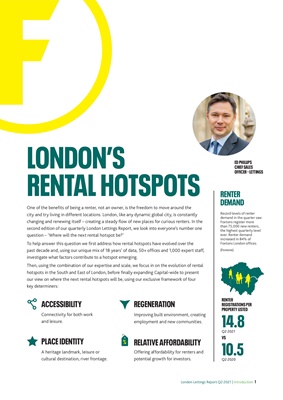
25-34
year-olds
23.3% 16.8% 7.1%
2020 saw an unprecedented exodus of overseas nationals leaving
London, although demand for rental properties remained surprisingly
solid as the priorities of domestic renters changed and an increase in
supply provided opportunities for renters seeking more value for money.
Supply surge
There was a marked migration out of
London in 2020, with an estimated
700,000 residents leaving the city.
Non-UK born residents returned home,
young people returned to their family
homes and students saw their studies
move online, all of which released a
significant number of properties onto
the rental market. A 65% fall in demand
from corporate relocations led to many
short-term rentals returned to the market
as traditional lets, at the same time as
international travel all but dried up and
short-term lets such as Airbnb were
switched to longer term rentals. The
resultant rental stock increase was
significant and this continued into the
second half of 2020 with the number
of new instructions 46% higher than
the equivalent period in 2019, peaking
in November with an 80% increase on
the previous year.
On the up
Despite the exodus of overseas nationals
from the London rental market, renter
registrations remained positive in 2020,
up 12% YoY. The rise was concentrated
in the second half of the year with a
22% YoY increase, fuelled by domestic
migration, after a small increase of 1%
in the first six months of the year.
After the strict lockdown in the spring,
renters began to drift back in and move
around the city as conditions relaxed later
in the year.
London movement
With the flexibility that renting allows
and an estimated 57% of Londoners
working from home during the first
lockdown (London Assembly), those
renters who remained in London
benefitted from a greater freedom of
choice in 2020, both in terms of where
they could live and the range of properties
available to them. 80% of renter moves
in the year were within London, and only
12% from the rest of the UK, with the
balance of 8% moving into London from
overseas. Evidence from Dataloft Rental
Market Analytics suggests that in 2019,
27% of London renter moves were from
outside of London.
Out of office
The new working freedom meant renters
required extra space to work from home
while the constraints of lockdown put
a greater priority on access to outside
space, both private and public. With
renters no longer needing to commute,
in the short term at least, 22% of central
London renters moved further out. They
were able to take their central London
budgets, move further from the office and
get more property for their money. The
average renter budget of £430 per week
for a 1 bedroom flat in Zone 1 could now
stretch to a 3 bedroom property in Zones
3-6 for £452 per week. It is little surprise
that Zones 3 to 6 saw the greatest
increase in renter demand in the year.
By early in the new year, demand had
begun to return to most central parts
of the city as renters took advantage of
greatly discounted rents. The first quarter
of 2021 has seen demand increase by 81%
YoY in Zone 1, compared to 56% in Zone
2 and 54% in Zone 3.
THOSE RENTERS WHO
REMAINED IN LONDON
BENEFITTED FROM A
GREATER FREEDOM OF
CHOICE IN 2020, BOTH IN
TERMS OF WHERE THEY
COULD LIVE AND THE
RANGE OF PROPERTIES
AVAILABLE TO THEM.
LONDONERS
ON THE MOVE 65% FALL IN CORPORATE
RELOCATIONS
ED PHILLIPS
CHIEF SALES OFFICER - LETTINGS
Foxtons
Unless otherwise stated, data is shown for 2020 vs 2019, Foxtons London offices only.
2 London Lettings Report Q1 2021 | Londoners on the move
GEN Y
SEIZE THE MOMENT
While students remaining at home to
complete their studies online and young
people returning to family homes resulted
in a drop in demand amongst 18- to 24-
year-olds in 2020, there was a marked
increase in demand from renters aged
between 25 and 34, known as Gen Y.
Demand from this group rose by 16% over
the year and, unlike other age groups, it
particularly increased in Zone 1, up by 23%,
as these young people took the opportunity
to rent central properties at discounted
rents. This trend accelerated in December
when there was an annual increase of 110%
- the combination of more confidence in
the job market, assessing living situations
for Lockdown 3 and the usual demand surge
ahead of the New Year culminated in this
trend continuing.
The largest fall in renter demand in
2020 was amongst renters aged 45 to 65,
a 20% decline. On average, this group of
renters spend £549 p/w on their rent,
21% more than the average. With 35%
of the 45 to 65 age group spending over
£1000 per week on rent, the reduction in
demand will have had a big impact on rents.
700,000 RESIDENTS LEFT
LONDON IN 2020
16% INCREASE IN DEMAND
FROM 25- TO 34-YEAR-OLDS
22% OF CENTRAL
LONDON RENTERS
MOVED FURTHER
OUT OF LONDON
80% OF RENTER MOVES
IN THE YEAR WERE
WITHIN LONDON
Economic Statistic
Centre of Excellence
Foxtons
Foxtons
Foxtons
Foxtons
Foxtons
Unless otherwise stated, data is shown for 2020 vs 2019, Foxtons London offices only.
ANNUAL CHANGE IN RENTERS
ANNUAL CHANGE IN
RENTER REGISTRATIONS
18-24
year-olds
35-44
year olds
45-65
year-olds
Over
65s
-10% -1% -20%
16%
7%
BY LEAD RENTER AGE
2020 vs 2019
Renters aged 25-34
ZONE 1
4.3% ZONE 2
12.6% ZONE 3
17.0%
London Lettings Report Q1 2021 | Londoners on the move 3